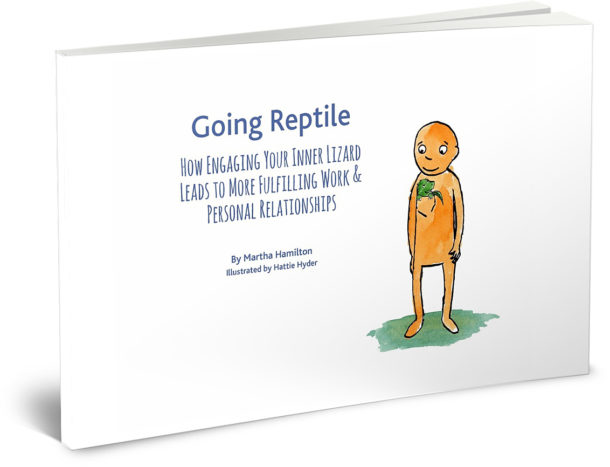 Welcome to this immersion series of posts exploring at how we tend to navigate stressful situations and environments (VUCA: Volatility, Uncertainty, Complexity, and Ambiguity) by “Going Reptile.” (If you’re just joining the series, you may want to go back to the beginning and read the introduction.) The reptilian responses are safety strategies (Fight-or-flight) that have been hard-wired into us by thousands of years of evolution, but that override our higher level human capacities and cause trouble in our personal and professional relationships.
Welcome to this immersion series of posts exploring at how we tend to navigate stressful situations and environments (VUCA: Volatility, Uncertainty, Complexity, and Ambiguity) by “Going Reptile.” (If you’re just joining the series, you may want to go back to the beginning and read the introduction.) The reptilian responses are safety strategies (Fight-or-flight) that have been hard-wired into us by thousands of years of evolution, but that override our higher level human capacities and cause trouble in our personal and professional relationships.
When situations feel threatening to our system, we react. How we react depends on what we learned to do as children, and depends on the environments we grew up in. These automatic reactions are designed to keep us safe. As we grow up, they feel normal. And they are – to us. Yet, we all have different styles, and combinations of styles. As life gets more volatile, uncertain, more complex, and ambiguous (VUCA), our style of reactivity becomes more visible. When we’re threatened we react.
What’s fascinating to me is how we react. It’s fascinating because that very reactivity is also a symptom of something larger. When we react, we simultaneously begin to lose access to our pre-frontal cortex (the part of our brain that helps us navigate VUCA situations)
Bigger Problems = More Reactivity = Less Pre-frontal Cortex.
And we need all the pre-frontal cortex engagement we can get to address the VUCA environments we find ourselves in. Reactivity is not always easy to recognize. Yet, even if not recognized, our access to the pre-frontal cortex is affected.
Learning to recognize and relate with these more subtle forms of reactivity is key to navigating our complex world. Yet, our intuitive, natural response is often to do all we can to suppress these reactions. You begin to see our dilemma.
I’ve broken down these response styles into four main categories – the Four F’s: Fight, Flight, Freeze and Fawn. In the first several posts of the series we’ve been exploring the “Fight” styles, which represent the ways that we fight back to stay safe or get what we need. Today, we’re going to shift gears and explore the “Flight” styles, which represent how we leave, either physically or otherwise in response to stress.
Today, we’re looking at the first of three Flight Styles: The Teflon One
The Teflon One
You might wonder why I’ve named this style The Teflon One. One way of leaving a situation is to learn to not have anything stick. Hence, Teflon.
This is not a physical walking out, like some of the other flight styles. This is a form of departure that leaves issues and problems to others to resolve. People who reflect this style learned to stay safe by not being responsible. “It’s not my problem,” is often a motto of this style of safety.
This is a tricky reactive style, as it can easily be mis-identified as panache or capacity to not get ruffled in difficult circumstances. And, on one level, that’s true. A person with this style of safety can walk through a cafeteria food fight and emerge unscathed, without a scrap of food on them.
The challenge is that most often, their co-workers emerge covered in muck. The mis-identification of this safety style can be devastating to teams and organizations, because when a safety style is celebrated rather than being recognized for what it is – a mechanism to find safety, demoralization quickly follows.
An indicator of this style is a capacity to fluidly reframe issues so they end up on someone else’s plate. The individual with this style moves on to the next thing, unaware of the trail left behind. This style is typically exasperating for co-workers, as it often goes unrecognized – or worse, celebrated.
What we need to remember about the styles is that they are reactive. When the reaction sets in, access to the pre-frontal cortex diminishes, as does the capacity to work together in a team. When this style is not recognized, the consequences can be significant.
Every style has served us in some way at some point, or it would not have been created. The Teflon One style provides a pressure relief valve of sorts, as responsibilities are moved elsewhere. The challenge is in the decreased access to the needed capacities that comes along with our reactions. One person might be an effective delegator, not coming from reactivity. A person with this reactive style might look similar to an effective delegator on the surface, but underneath be shutting down their capacities as they react. It’s a subtle and important difference.
In our current VUCA environments (volatility, uncertainty, complexity and ambiguity), we need access to our own and our team’s capacities. When reactive styles go unrecognized, capacity diminishes.
All of our styles are developed as we grow up, and are created and engaged in order to navigate challenging territory. We all have styles. And when we create them, they are brilliant. The challenge is that those same styles that are so well honed and practiced feel like normal life to us. We simply don’t notice that we’re engaging them, nor do we notice their impact on our capacity to navigate effectively.
The good news is that it does not take a lot of work to begin to recognize our styles – the first step to bringing more capacities online in challenging situations. Most of us need all our capacities online to be effective. To have 50% or more of our bandwidth allocated to reactivity and safety is too costly.
A few things you can do:
Observe: Get to know the reactive styles that are showing up in you, and those around you. This is not about blaming or shaming, this is about humble recognition. Gentle recognition is an important first step.
Understand: Reactivity is wired into us by design – it is not a flaw. It’s a human safety feature. The question is whether reactions that supported us when we were younger still serve us now, particularly in a work or relational context.
Get and Stay connected: Shame, blame, complaining, explaining, justifying, defending, denying and not taking responsibility (for this style) are indicators of disconnection – from ourselves and others. Many of us learned to disconnect as children, and these indicators – this disconnection – may seem so normal, so usual, that it is hard to see as an indicator of anything. Yet, as adults, we need the capacities that come online when we’re connected. If we’re to face a VUCA environment (volatile, uncertain, complex and ambiguous) with the capacity to navigate it effectively, connection is required.
What we resist persists: If you find yourself in some form of redirecting responsibility, you are likely in the middle of this dynamic. For some of us, this is so “business as usual” that it may be hard to recognize as a contributing factor to the very issues that you and your team need to address.
Get to know your styles: This brings us back to observation. Compassion is central to loosening reactive styles. If you blame yourself or others for how you or they react, the safety styles – the reactive patterns – become more entrenched and cleverer. Their job is protection. They do it well. Practice noticing these patterns, these reactive styles of navigation. See if you can gently appreciate that they were created for really good reasons – even if they don’t seem to serve the family, team or organization in the present.
In my next post, we’ll continue to explore the Flight styles. . .

